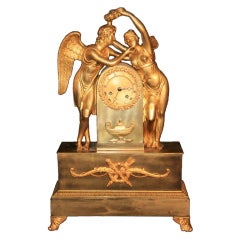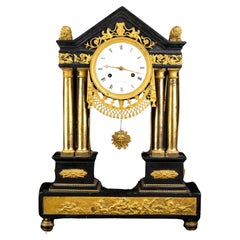Gilt Clocks
123
to
10
64
27
123
123
123
202
123
84
72
39
25
19
14
12
10
7
4
4
3
2
1
2
119
2
2
Height
to
Width
to
119
111
21
17
16
120
112
2
2
1
3
2
2
1
1
Style: Empire
Technique: Gilt
Monumental French Gilt and Patinated Bronze Malachite Clock
Located in Los Angeles, CA
A very large and impressive 19th century Empire style gilt and patinated bronze malachite mantel clock depicting 'Psyche Crowning Cupid.'
Psyche crown...
Category
19th Century European Empire Antique Gilt Clocks
Materials
Malachite, Bronze
Unusual Swedish Early 19th Century Empire Wall Cartel Clock by Cederlund
Located in Worpswede / Bremen, DE
An unusual Swedish Empire giltwood striking wall clock from the early 19th century. The white painted Arabic dial signed by the clockmaker ‘Jon. Ce...
Category
Early 19th Century Swedish Empire Antique Gilt Clocks
Materials
Wood
19th Century French Empire Gilt Dore Bronze Figural Amour & Psyche Mantel Clock
Located in Philadelphia, PA
Very fine gilt bronze figural mantel clock featuring cupid (also known as amour) swooning a butterfly winged psyche. This French mantel clock dates back to the early 1800s and is ver...
Category
19th Century French Empire Antique Gilt Clocks
Materials
Bronze
19th Century Empire French Black Marble Bronze Mantel Clock
Located in Roma, RM
Bronze and marble mantle clock - France, Paris 18th century, signed GREBER
Black marble temple case with gilt bronze lions. Circular dial with Roman nume...
Category
1810s French Empire Antique Gilt Clocks
Materials
Belgian Black Marble, Bronze
Early 19th Century Pendule Portefaix, Firegilt Bronze, Empire, Circa 1810
Located in Greven, DE
Pendule Portefaix
France (Toulouse)
bronze, enamel
Empire around 1810
Dimensions: H x W x D: 36 x 28 x 11 cm
Description:
Beautiful fire-gilded and patinated bronze pendulum from the early 19th century. Depicted is a young man carrying a large cotton package on his back. In his right hand he holds a letter, with his left he is leaning on a bamboo stick. His tobacco pipe is stuck in his hat string, and he carries his water bottle on his belt.
In interesting color contrast is not only the fire gilding to the deep black patinated bronze, but also particularly striking are the white glass eyes.
The ciselleur has managed to make materials tangible through different surface treatments. For example, the skin is discreetly hatched differently from the cotton fabric of the trousers; the bottle, bracelets and pannier are polished in gold. The proportions of the figure are perfectly struck, and the drapery on the trousers emphasizes the dynamic movement.
The heart of the watch is an 8-day movement with date from the Prevost Freres workshop, which is attested in Toulouse from 1809.
The Breguet hands are blued, the pendulum is suspended on a thread, typical of the time. The clock strikes a bell on the half and full hour.
Fun Facts:
The depiction of Le Portefaix is by Parisian bronze caster Jean-André Reiche, who registered his artistic design in Paris in 1808. In addition to the depiction of the cotton picker, there are numerous other pendulums that deal with the theme of colonization. Other themes from the "new world" were also treated artistically - exotic animals and plants - butterflies, birds of paradise, tobacco and spices....
Today's viewers react to the objects with both fascination and irritation. Enthusiastic on the one hand by the obvious quality of the detailed bronzes, on the other hand distanced-cautious because of the possible discrimination that is suspected behind it. The ambivalence of this feeling motivates the search for the conditions of origin of these pendulums.
Europeans found their new ideal of the natural man mainly in fictional and realistic travelogues about the Indians of North America...
Category
Early 19th Century French Empire Antique Gilt Clocks
Materials
Bronze
Impressive Empire Period, Bronze Gilded Pendulum Clock, Stockholm
Located in New York, NY
Stunning and majestic in its size and proportion, Empire Period Pendulum Clock, made in Stockholm (1810-1835)
Sculpted, bronze-gilded clock featuring flanking cornucopia and crowned...
Category
19th Century European Empire Antique Gilt Clocks
Materials
Bronze
18th Century France Louis XVI Gilt Mantel Clock by Lepine, 1790s
By Lepine
Located in Roma, RM
Wonderful golden clock, signed Jean-Antoine Lépine,
(born November 18, 1720, Challex, France, Died May 31, 1814 (aged 93)Paris, France)
a wonderful exam...
Category
1790s French Empire Antique Gilt Clocks
Materials
Bronze
Recently Viewed
View AllMore Ways To Browse
French Gilt Figural Clock
Empire Bronze Mantel Clock
Painted Face Grandfather Clock
Antique Old Clocks
Old Antique Clocks
Louis Xv Figure
Antique Old Clocks Antique Clocks
Antique Old Clock
Old Antique Clock
Old Clocks Antique Clocks
Old Clock Antique Clocks
Very Large Antique Clock
Bronze Pillars
Gilt Bronze Figural Clock
Pendulum Art
Ormolu Birds
Brass Door Bell
Mantel Ring




